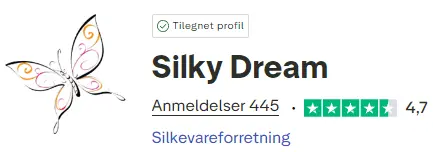- Silky-Dream – Luxury Silk Apparel & Bedding in 100% Mulberry Silk
- Info Silk
- Help with allergies
Help with allergies
Hypoallergenic silk – natural relief for sensitive skin
Silk – nature’s skin-friendly fiber
Silk is a natural protein fiber produced by the silkworm to form its cocoon. The most commonly used type is cultivated mulberry silk, which is fine, lustrous, and nearly white when processed. It differs from wild silk, which is coarser and brownish in appearance.
Why silk is ideal for allergy sufferers
Silk consists of two components: fibroin, the strong and smooth core, and sericin, a natural adhesive with antibacterial properties. Once sericin is removed, the silk becomes extremely soft and hypoallergenic – perfect for sensitive skin, eczema, or psoriasis.
Proven healing properties
Research from Japan has shown that silk can accelerate skin wound healing by up to 7 days, reduce scarring, and promote collagen production. Silk is not only comfortable – it nurtures and protects your skin actively.
Temperature-regulating material
Silk adapts to your body temperature, keeping you warm in winter and cool in summer. Its hollow structure removes excess heat and moisture, making it ideal for bedding and sleepwear – especially for those with allergies or dry skin (xerosis).
Strong and durable
Silk fibers are incredibly resilient – even stronger than steel by weight. They withstand mechanical and thermal stress and retain their structure at high temperatures. Silk is also resistant to most acids and bases, making it a long-lasting choice.
Moisture absorption without feeling wet
Silk can absorb up to 30% of its own weight in moisture without feeling damp. It absorbs sweat while allowing your skin to breathe – always feeling soft and comfortable.
Natural protection – straight from the cocoon
Silk contains natural substances from the cocoon that protect against bacteria and irritation. Because the processing is gentle, these properties remain in the final product – giving you a natural barrier against allergens.
Silk from Silky-Dream – your skin’s best friend
At Silky-Dream, you’ll find a wide selection of silk products for allergy sufferers – from bedding and sleepwear to accessories and underwear. Our products are made from 100% Mulberry silk and are designed to offer you comfort, relief, and luxury – every single day.
References
- Molloy, H.F., Lamont-Gregory, E., Idzikowski, C., Ryan, T.J. (1993). Overheating in bed as a key factor in common dermatoses. International Journal of Dermatology.
- Celedon, J.C. et al. (2001). Silk hypersensitivity and asthma cases in rural China. Pediatrics, 107:E80.
- Wen, C. et al. (1990). Silk asthma in children: A report of 64 cases. Ann Allergy, 64:375–378.
- Harindranath, N., Prakash, O., Subba Rao, P.V. (1985). Occupational asthma in silk filatures. Ann Allergy, 55:511–515.
- Uragoda, C.G., Wijekoon, P.N. (1991). Asthma among silk workers. Journal of Society of Occupational Medicine, 41:140–142.
- Sugihara, R. et al. (2000). Prevention of collagen-induced arthritis in DBA/1 mice via oral administration of AZ-9. Immunopharmacology, 49:325–333.
- Cook, J.G. (1968). Handbook of Textile Fibres. WS Cowell Ltd, Ipswich.
- Venugopal, B.R. (1991). Colourage, 38:46–47.
- Skridtet, W.J.B. (1956). A Silkmoth Breeder’s Handbook. Lowe & Brydone Ltd, London.
- Bush, S. (1987). The Silk Industry. Shire Publications, Buckinghamshire.
- Butler, E.A. (1910). Silkworms. Swan Sonneschein & Co Ltd, London.
- Robson, R.M. (1985). Silk: Composition, structure and properties. In: Lewin, M. & Pearce, E.M. (eds.), Handbook of Fibre Science and Technology, Vol. IV. Marcel Dekker Inc., New York.
- Dhavalikar, R.S. (1962). Journal of Scientific & Industrial Research, 21:261–263.
- Gulrajani, M.L. (1992). Rev Prog. Dyeing, 22:78–79.
- Venugopal, B.R. (1991). Colourage, 38(2):53–54.
- Changsarn, C. et al. (1987). Utilization of natural silk waste. Rajamangala Institute of Technology, Bangkok.
- Peters, R.H. (1963). Textile Chemistry Vol. I. Elsevier Publishing Company, New York.
- Likitbanakorn, P. (1991). M.Sc. Thesis, University of Leeds.
- Tsukada, M., Hirabayashi, K. (1980). Journal of Polymer Science: Polymer Letters, 18:507–511.
- Sadov, F., Korchagin, M., Matesky, A. (1978). Chemical Technology of Fibre Materials. Mir Publishers, Moscow.
- Rheinberg, L. (1990). Textile Progress, 21(4):4–5.
- Das, S. (1992). The Indian Textile Journal, 102(12):42–46.
- Lavere, E.S. (1988). Textile Monthly, August:9–14.
-
45% OffNew
Customer Reviews
“I’ve never slept better – the silk feels like a dream against the skin.”
– Lise
“Fantastic quality and lightning-fast delivery. I’ll never buy other nightwear again.”
– Jonas
“My skin no longer itches – the silk underwear is truly allergy-friendly.”
– Camilla








